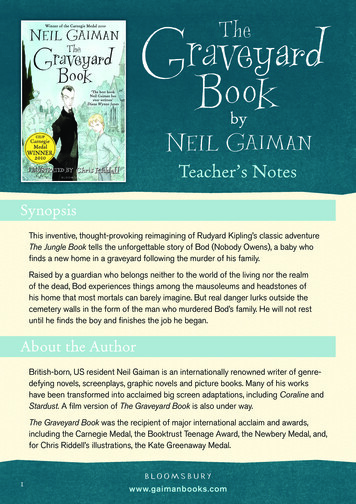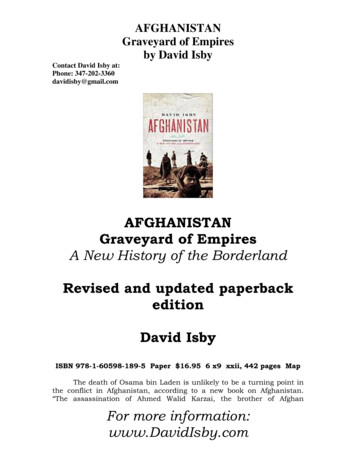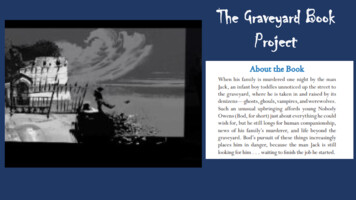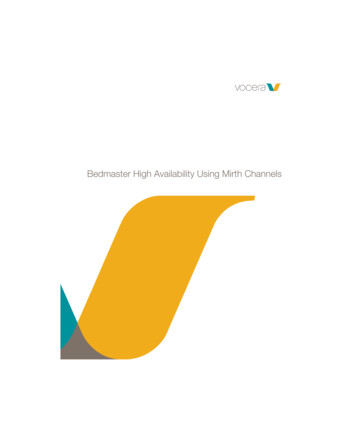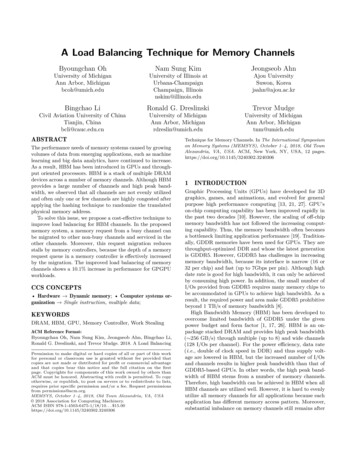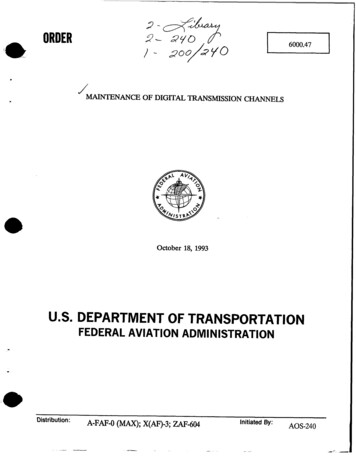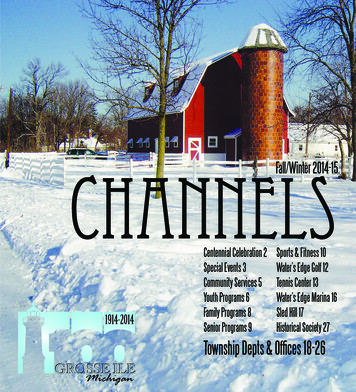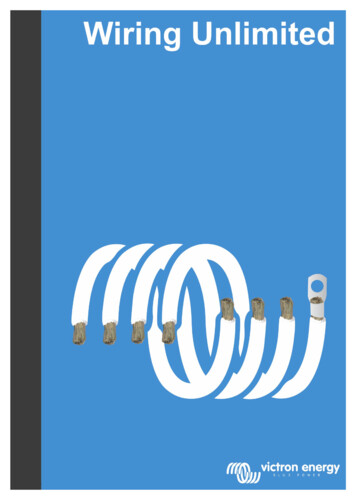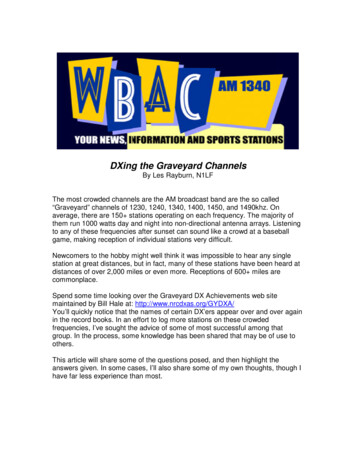
Transcription
DXing the Graveyard ChannelsBy Les Rayburn, N1LFThe most crowded channels are the AM broadcast band are the so called“Graveyard” channels of 1230, 1240, 1340, 1400, 1450, and 1490khz. Onaverage, there are 150 stations operating on each frequency. The majority ofthem run 1000 watts day and night into non-directional antenna arrays. Listeningto any of these frequencies after sunset can sound like a crowd at a baseballgame, making reception of individual stations very difficult.Newcomers to the hobby might well think it was impossible to hear any singlestation at great distances, but in fact, many of these stations have been heard atdistances of over 2,000 miles or even more. Receptions of 600 miles arecommonplace.Spend some time looking over the Graveyard DX Achievements web sitemaintained by Bill Hale at: http://www.nrcdxas.org/GYDXA/You’ll quickly notice that the names of certain DX’ers appear over and over againin the record books. In an effort to log more stations on these crowdedfrequencies, I’ve sought the advice of some of most successful among thatgroup. In the process, some knowledge has been shared that may be of use toothers.This article will share some of the questions posed, and then highlight theanswers given. In some cases, I’ll also share some of my own thoughts, though Ihave far less experience than most.
In your experience, what is the most productive time of day for hearing DXon the graveyard channels?Although my recordings at the top of the hour overnight have been quiteproductive, I still think sunrise and sunset are the best times on any frequency,including graveyards. -Paul LaFreniereEarly morning prior to sunrise because no two mornings are the same and DX cancome from any direction.-Mike StonebridgeI haven't done an analysis of the times of myloggings, but they are fairly well spread through the nighttime hours.Basically, the best times are those in which propagation is abnormal insome way, favoring certain directions and/or distances, and thus stirringup the GY mix. This includes sunrise/sunset of course, as well as timeswhen there are auroral or other disturbances. Sunrise has beenparticularly fruitful here - so much so, that I often record and check BOHintervals that occur within an hour or two of sunrise.-Barry McLarnonDefinitely the use of overnight, unattended recording is the big boon forme. It's responsible for my GY totals increasing from one local per channel(total 6) to my current total of 95 across the 6 frequencies. I neverrealized that, by parking on a frequency, something would actually pop outof the noise at ID time :-) My personal best is three different station IDsat one TOH. –Brett SaylorThat has changed over the years. It used to be between 2300 and 0105local time. Second best would be 0100-0300 for then-common frequencychecks. Today, I'm not sure if there is a 'best time', but sunrise andsunset enhancements apply to all channels equally, so that might be thebest shot today.-Russ EdmundsThat is a question I ask myself often. After about a year of this, I have concluded thatabout an hour before sunrise to two hours after and one hour before sunset totwo hours after are the most productive for me.-Russ JohnsonA bit after local sunrise in order to grab onesthat are not too far away (e.g. Virginia fromOntario), but at the same time while a channel soundsless cluttered. After local midnight or 1AM some stations still sign off,leaving less clutter on the channel. And sign offsstick out!-Neil WolfishUse some sort of overnight unattended recording equipment. I use TotalRecorder and it has enabled me to increase me GY totals from 25-30 GYerslogged to my current 73 GYers in the log.-Bruce Winkelman.Most DX’ers seemed to be in agreement that there was no “best” time of day,other than SRS/SSS, when it comes to logging new ones on the graveyardchannels. It’s more a matter of being at the right place at the right time. The onetool most often cited to make this possible is the use of the “Total Recorder”software by High Criteria. At a cost of only 11.95 for their basic software, it maybe the best value in DXing. Most DX’ers seem to record a period of about twominutes prior to the top of the hour (TOH) until about seven minutes after.
Experience indicates that at least 1/3 of all loggings will come just after networknews at around five minutes after TOH.Total Recorder has a “schedule” feature that allows you to set up TOHrecordings for the entire day. With a few more clicks, you can convert these filesinto smaller compressed .MP3 files. Most DX’ers will then review theserecordings during the next day.Some burn the files to CD’s and listen to them during their commute times.Others will steal a few minutes during their lunch break. But all agree that thisone tool is responsible for a lot of new loggings.You can download a trial copy for free at:http://www.highcriteria.comSome comments about this software are in order:I've been recording for over a year, and I record TOH from xx:58-xx:03every hour from before local sunset to after local sunrise the nextmorning. I record xx:29-xx:35 on the BOH for the "critical" hours, too. I
try to review the recordings the next morning, but usually don't get to ituntil the weekend (if ever!). I usually will drill directly to the xx:59:50mark to catch the few seconds before TOH where most ID's occur. I know Imiss the other possible times for ID's, but since I don't have a lot oftime that's all I can afford. Oh yes, by the way, I sync my PC clock dailyusing NISTtime [software] to make sure it's within a second or two ofactual time. –Brett SaylorI no longer have the patience to sit on the graveyard channels for longperiods any more unless I'm receiving a solid signal, which isn't veryoften. Just too much of a jumble, so all my graveyard DXing is done by timerand recorder. It's quite amazing how the channel can be a mass of stationsand right at the TOH I hear a clear full ID, and then it's gone. Most nightseverything is set for the period two minutes before to three minutes after everyhour from midnight to sunrise. This method has produced 13 new graveyardloggings so far this winter.-Mike StonebridgeIs there a season of the year that seems to result in more new loggings onthe graveyard channels?Summer has definitely been more productive for me. My ownopinion on this is that in the winter it is still nighttime conditions at0500 & 0600. In the summer it is SRS conditions at those hours.Nearly all of my loggings have been from March or April through September.I have never bothered to determine the length of time any one stationdominated the frequency or the weather conditions at the time [pressurereading, temp, whether it is cloudy etc].I was always thinking of determining what the average distance is for these loggings. I do knowthat many times a station will show up for two or three nights consecutively and thendisappear for good. Also--there are graveyard pests. I have found that twoor three stations on each frequency are in often.- Paul LaFreniereI find that spring and summer are best for GY; however, I can’t provide you with an explanation.-John Vervoort.Absolutely! Many of my best GY catches have been in the summer months.Propagation conditions are different than in the winter, so the "mix" tendsto be different. I'm also convinced that sporadic E plays a part in MWpropagation, and Es is obviously more common in those months. With fewerinteresting catches available on the other frequencies, summertime is agreat time to concentrate on the GYs. –Barry McLarnonSummer static is less of an issue on a frequency where 50 stations are piling up to produce aconstant S9 40db signal. Though I check in with the GY frequenciesthroughout the year as conditions are always changing. –Rick KenneallyA DX season of any kind is pure myth, especially nowadays, with modernreceivers and antennas successful MW DXing can be anytime of year. The onlydifference between the warm and cold weather months will be that localthunderstorm activity can cause temporary shutdowns. (Examples:Thunderstorms in New Hampshire made DXing impossible during the recent WTAM
downtime, yet one summer while visiting Tampa, Florida, I could DX betweenstorms to log some interesting Cuban signals.)The best time to DX during the summer months will be at local sunset when atmosphericconditions are varying widely (although thunderstorms tend to be strongest before localsunset), and during the pre-dawn hours when thunderstorm activity cools offfor the most quiet noise levels. -Bruce ContiI agree [that summer can be more productive] Atmospheric conditions are more variable and notas good, often resulting in more surprises. That said, however, I've also found, as BobFoxworth mentioned, that conditions to New England from the Middle AtlanticStates are best then. The final reason is the existence of extensivenetworks for both major and minor league baseball.-Russ EdmundsHow do auroral (AU) conditions affect the graveyard channels? Do you findthese periods to be more productive?Being this far north aural conditions usually wipe out all DX atthis location. During a high aural period I consider myself lucky if I canhear any station outside of Alberta.-Mike StonebridgeOnly if there are stations 100 miles or so to the North whichnormally dominate the frequency.-Russ EdmundsAU conditions are a good time to check out the GYs, ifyou can tear yourself away from the other stuff. My logging of WFOYwas in AU conditions, and there are quite a few more like that in the log.It's hard to imagine hearing a Florida station essentially alone on a GYchannel under any other conditions from this location. (Ontario, Canada)-Barry McLarnonThey bring in neat stuff for Ontario DXers, like SC,FL, AL. as long as the AU isn't too severe. Ifthat happens, then all I get is ground wave from thenearest GY station to me.-Neil WolfishAnswers to this question seemed to vary a lot by the location of the receiver.Here in the Southern US, I find that AU conditions can have the effect of reducingsome of the clutter on the crowded local channels, by attenuating signals fromNorthern stations. Many of my new loggings from Florida GY’s have come duringperiods of severe AU conditions.Are there any types of antennas, equipment or receiver settings that youfind helpful on these crowded channels?ECSS [Single Sideband] is about the only way I DX these days. It is much easier topull an ID out of the jumble. That is one way the Drake R8 really"sings" in the ECSS mode. Many catches I would never had heard withoutit.-Patrick MartinOne technique I use is to tune off frequency 1-2 kHz. Sometimes stations can be heard out of thehash. Then I de-tune my loop (variable capacitor) and then tune back into the frequency until astation is audible. I don't completely peak the signal. This is how I heard KSMA on Saturday, infor about 8 minutes before they faded down.-Martin Foltz
The passband tuning on my R8 makes it possible to choose a sideband andpeak it for the best sounding audio on the graveyards, which is important I find that getting rid of the bassy "rumble" of the GYs makes the ID'sstand out better.-Brett SaylorI use an AOR-7030 receiver set on b/w of 4 kHz and myK9AY antenna. I find this antenna is superior to my EWE because it has muchlower noise levels. I usually adjust the null against one of the regulars,if one is on top.-Mike StonebridgeFor unattended recording, the Sony 2010 is my choice. With its mechanicalon/off switch, it works great withdigital timer and mini-disc recorder - plusthe synch detect is very helpful. For live listening, my choice is a modifiedIcom R75. Copying in ECSS mode is a dream with the R75. Passband tuningis very effective. I am also a big fan of the little Koss Koss EQ-30 or EQ-50portable equalizer. Some adjustments with that can make the difference in understandingan ID or not. Of course, good headphones are essential. My current favorites are theTelex Airman 760 (aviation use).-Russ JohnsonThe Quantum Phaser has been valuable as well, allowing me to null thesemi-local GY’ers and with luck, my one local on 1340. On all GYfrequencies except 1340, I can set the phaser to enhance reception tothe north or south. I haven't had as much success peaking reception tothe east or west for some reason.perhaps it is due to theconfiguration of the wires.-Bruce WinklemanI always use SSB mode, choosing whichever sideband has the least adjacentchannel splatter, along with a 4 kHz IF filter.-Barry McLarnonOne type of antenna that has shown some promise on the graveyard channels isthe use of NVIS [Near Vertical Incidence Signals] antennas. Most of these arecommon antennas mounted close to the ground so that they favor high angleskywave signals.Usually DX’ers seek to receive low angle signals, since these represent thestations farther away from the receiver. But with graveyards, using a NVISantenna can have the effect of “turning down the noise”on the frequency byreducing the signal levels from those more distant stations.My NVIS antenna is a simple dipole cut for the 80 meter ham band, mountedonly ten feet above the ground. Since erecting it, loggings of “medium distance”GY stations has improved, adding several new ones in the 400-600 mile distancerange. The NVIS antenna also seems to work wonders when used as a sourceantenna for my Quantum Phaser. Using it in combination with a whip or beverageon the ground (BOG) can dramatically affect null levels.Other antennas such as loops seem to be less useful on GY channels due to thenumber of signals coming from multiple directions. They can be very helpful ifyou have a local station on one or more of the frequencies.
Do you use software to process your recordings of graveyard ID’s andwhat results have you seen? Is there other software that you find useful?Cool Edit [Now marketed as Adobe Audition] is essential for normalizing, filtering, and slowingdown the playback to determine IDs. Probably half of what I've added to the log isthe result of this tool. I would not have WKDK's DX test (where this allbegan) or Poynette's WHFA without Cool Edit.-Gerry htmlRegarding other software I do use TrueTime WinSync which keeps my computer (with cablemodem) within a second or so of accurate time!-Tom lI play back in WinAmp, but if I need to edit I'll use CoolEdit. I don't donearly the slow-down/clean-up that Gerry Bishop or Russ Edmunds do, but will occasionallytweak a file for better readability. I recently downloaded a trial versionof Adobe Audition (which is what they renamed CoolEdit when they took itover) but I don't see many reasons to consider switching to it (consideringthe price).-Brett Saylorhttp://www.winamp.comMy personal experience is with Sony’s Sound Forge 7.0 software. Similar toAdobe’s Audition software, this software has a lot of uses when dealing withrecorded computer files. I import my files one at a time from Total Recorder.
Right away, you can see a very detailed waveform of the recorded file,sometimes allowing you to visually see where events such as a TOH ID takeplace. You can slow down portions of the file (such as an ID) to make it easier toseparate consonants, you can apply advance noise reduction algorithms, andapply EQ to help pick up key words. Both Sound Forge and Adobe Audition areexpensive, but they’re also very powerful. I’ll echo Gerry Bishop’s comment;there are quite a few new ones in my log that I wouldn’t have gotten without Products/Any thoughts on why some nights the GY channels seem to just be ajumble of noise with few clear ID’s, while other nights yield lots of clearID’s?I've never timed it out, but my experience has been shorter periods ofone station dominating - more like 3 to 5 minutes. But I've noticed noparticular patterns of note other than the 'usual' ones such as severeaurora or the approach of a very strong weather pattern in winter.-Russ EdmundsWhen the GY stations were 250/500 w at night. the situation was VERYdifferent than it is today. As others have noted, stations would fade inand out and listening to a GY frequency produced many new loggings for me.However, since they all are now 1kw day/night, the situation has changed,at least for me! There is typically one dominant station. and a bit ofa jumble underneath. Very occasionally, a 2nd or 3rd station will fadein for a bit. but with IDs being what they are these days (perhaps once
an hour) it is very difficult to LOG anything. And the fade ups tend toonly last for 2-3 minutes vs. the 15-20 minutes of the past.-Phil BythewayThis has always been a mystery. And more the mystery when three TOHpass with just a jumble, and the next hour will bring four ID's in 15seconds, each clear. I'll offer that when signals are much jumbled,propagation is quite good to the point of overwhelming. I have no evidence,Just a hunch. –Gerry BishopThose of us who like to hang around on the GY channels often remark on theway they are usually a total jumble, and then, inexplicably, sometimesthey magically become un-jumbled and provide some good loggings.Last night I had a good example of this phenomenon. I trolled 1230 with timedrecordings overnight. For the TOHs at 0100 and 0200, there was mostly ajumble with IDs.Then the veil lifted, and I had a remarkable series of TOH catches.At 0300, a crystal clear ID from WGRY Grayling MI, nearly alone. At 0400,the same thing, but this time it was WMSH Sturgis MI. Ditto at 0500, onlythis time it was WTKG Grand Rapids MI doing the honors. WTKG was stillholding on at 0600.At 0700, the dominant station went through TOH withmusic, but at 0701 provided a nice clear ID as WCWA Toledo OH. At 0800,WCRO Johnstown PA stepped up to the plate. WCOL Columbus OH also slippedin there at times, so that's 8 good IDs in one session, and I couldprobably find a few more if I had time to listen to more of therecordings.-Barry McLarnonYes, GY DXing isn't exactly what it used to be. I have the samesituation both in Azusa here and also back in San Jose. One stationtends to dominate for the most part with hash underneath; though thereare some frequencies where two or three will try to equally dominate (1490 is agood example).1340 is a very interesting frequency, it tends to sound likea pure 'rumble', no one really dominates except when I get decent conditions tonorthern Baja then XEAA will totally dominate. 1450 is a beautifulfrequency down here, I had Reno dominating the other night, some nights it'sEscondido, some nights Porterville, even Tucson. Depends on conditionsparticularly if AU.-Robert WeinThis phenomenon is widely reported, but after over a year of coordinatedmonitoring by DX’ers of the same channel overnight, we’re no closer toexplaining how it works. It is what adds to the thrill of DXing these crowdedchannels. You’ll review recordings of five or six hours in a row with only a jumbleof noise and the occasional pest that you’ve logged ten times before, and thensuddenly be rewarded with a station that you’ve never heard a single trace ofbefore and it may even be crystal clear.
What advice would you give to other DX’ers about the graveyard channels,especially to newcomers?Patience, patience, patience. It is so much harder today for so many reasons - more stations,more full time operations, no special tests ( frequency checks ) increased noise.Other than unattended recordings, I don't spend a lot of time on GY's any more because the'return on investment' of time is so low in terms of new loggings.-Russ EdmundsTwo words: timed recording. Whether I'm at the receiver or not, I try notto ever let a TOH slip by without recording on some channel, and I oftenleave the receiver on a GY channel if I'm not chasing something else.Recording onto a PC makes it easy to review them, and you can try variousprocessing to enhance the recordings if you're into that, not to mentionarchiving your catches and getting help with UNIDs by sharing audio clipswith others. My PC is on 24/7 and is near my receiver, so it's easy toset up timed recording and just let it run. I usually record 8 minutesegments around both TOH and BOH, starting at :29 and :59 minutes past thehour. The recording period extends at least an hour on either side ofsunset/sunrise. It doesn't take long to review a bunch of TOHs (if I'mshort of time, I don't bother with the less-productive BOHs). If I hearsomething interesting but I can't ID it right away, I make a clip, labelit, and store it away in an UNID directory. Some rainy day whenpropagation is lousy, I can listen to them again, and occasionally am ableto dig out an ID that I missed previously. In addition to listening tothe time right around TOH, it's also very worthwhile to check around 4 or5 minutes past TOH, when many stations are coming out of their news break.Even if you don't do timed recording, it's essential to have goodrecording capabilities. Without it, GY DXing would just be frustration.And if you want to be truly successful at it, timed recording is a must.-Barry McLarnonWhat I used to do is to "sit" on the GY freq. near the top of thehour. I used to run a timer to turn the recorder on from :58 to :02 or:58 to :07. Sometimes an ID will run between the spots out of the newsand the programming which is mostly satellite talk on the AM dial now.The GYers can be a lot of fun. Any person new to DXing shouldspend time on these channels. You never know what might pop in!-Patrick MartinWhen listening, use head phones, and an audio recorder. Spend timeat the dials. Graveyard stations are a lot of fun.-Doug PiferI'm fascinated that we're all parked on the same frequencies at the same time, andwe so often don't even seem to experience similar propagation. There's a lot to besaid for being in the right place, right time, and knowing what to do withthe sound that comes through the headphones. –Gerry BishopUse some sort of overnight unattended recording equipment. I use TotalRecorder and it has enabled me to increase my GY totals from 25-30 GYStations logged to my current 73 in the log.Definitely rig up some unattended recording method. Let your top of hour
recording sessions go at least till: 07 past the hour. I use the Russ Edmunds:58-:07 method. This will let you catch some local programming (ads, weather,ID, local news, etc) after the network news is over.If pressed for time, fast forward though the network news - you are unlikely tocatch anything new during that. Set up multiple antennas if possible and alternateduring the week to improve chances of snagging something. For me, having amanageable number of tracks to listen to each day (six or so) is preferable to lettinga huge number build up.When the frustration of not logging anything new for a long time gets the better of you,take a break on a non-GY frequency at least until you log a new one!-Russ JohnsonDon't trust your ears, at least at first.listen, re-listen,re-listen and re-listen again. Go back later and re-listen again to therecording.-Bruce WinklemanYou must have at least a few months of experience and also a great deal of patience.The more you practice, the better you’ll become.-John VervoortLearn the format of your local/regulars;Grab a good book or a crossword puzzle and parkyourself on a frequency until you determine who isdominating. Then move on to the next frequency.If you have an "opening" to one area, capitalize!If you hear Green Bay on 1400, look for otherWisconsin Graveyard stations too.Don't be fooled by a strong signal with somethinglike Jim Bohannon or Art Bell. you might discoverthat you are hearing three stations all carrying thesame thing until they break for news and ID. And thenyou have 3 weak signals;Have a tape recorder running to play back IDs andspots (especially when "E" can sound like "B", etc.)Have some familiarity with professional andcollege sports nicknames;Patience.-Neil WolfishI wouldn’t do a session with the web site www.100000watts.com.It seems to be the most up to date listing of stations, their formats,etc. available on the web. For portable operations, I always carry a copyof the latest NRC AM Log. –Les Rayburn
So, you’ve gotten the bug and want to become a “gravedigger” where shouldyou turn for even more information about logging these elusive stations.There is an e-mail list devoted solely to DXing the Graveyard Channels. Usuallywe pick a channel to concentrate on during the coming week then exchangenotes on what we heard. Frequently members will post short sound files ofstations they are having troubling Identifying. Often just getting another set ofears to listen can help clear it up.We also exchange information about the stations, and have limited discussionsabout the technical side, usually software dominates those topics.To subscribe, visit this web other great source of information is the original article on the subject, writtenby the master, Bob Foxworth. This reprint is available from the National RadioClub. Ask for C Reprint is D11, "Successful Long-Distance Reception on theClass-IV Channels".Written in early 1974, but much of the information is still very valid. I highlyrecommend it to anyone serious about this part of the hobby.NATIONAL RADIO CLUB, INC.Publications Center Order FormP.O. Box 164, Dept WMannsville NY 13661 USABill Hale’s excellent web site is also a vital source of information. Bill keeps trackof the record reported reception distance for each station. He even divides it intotwo types, Prior to 1960 and after. One check of the records indicates that thingswere much easier to log in good ole days.http://www.nrcdxas.org/GYDXA/Listening to the graveyard channels holds other rewards as well, especially earlyin the morning. You can still find quite a few locally owned and operated stations.You’ll get school closing, lost puppies, and a lot of the regional charm that alwaysmade it so interesting to listen to distant radio stations.It’s still possible to hear the national anthem or phrases like, “WBAC nowconcludes another broadcast day” Perhaps that’s why these channels earnedthe nickname “Graveyard” to begin with. This is the way radio used to be andperhaps someday will be again.
The author wishes to thank all the DX’ers listed in the article for sharingtheir wisdom with all of us. Any mistakes are mine, any credit shouldrightly be theirs.
DXing the Graveyard Channels By Les Rayburn, N1LF The most crowded channels are the AM broadcast band are the so called “Graveyard” channels of 1230, 1240, 1340, 1400, 1450, and 1490khz. On average, there are 150 stations operating on each frequency. The majority of them run 1000
